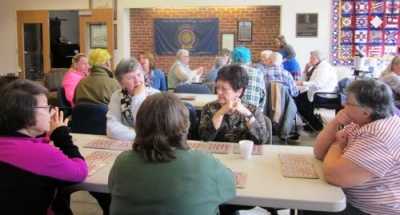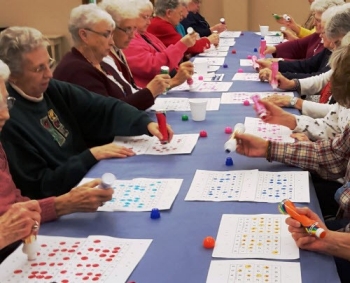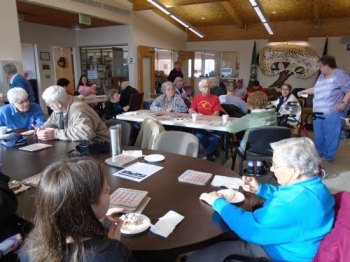How Pie and Bingo was Born
This is the first in a new series on WebJunction published in collaboration with the Association for Rural and Small Libraries (ARSL), highlighting innovative programming from member libraries serving small and rural communities. Thanks to our first contributor, Clancy Pool, Manager, St. John Branch, Whitman County Rural Library District (WA), Library Journal Paralibrarian of the Year 2014, and ARSL Treasurer and Executive Board Member.

A recent inquiry on ARSL’s amazing and active listserv (a wonderful benefit to Membership!) requested suggestions for senior programming ideas. I responded with the story of Pie and Bingo, by far our most popular program.
The Beginning
About five years ago, we received a grant to reach out to rural seniors to improve their health and reduce their social isolation. The first program we tried was a caregiver coffee, which offered information about services available and allowed sharing amongst caregivers. We also planned to have activities in a different room for the family member that was being cared for. The problem? Nobody came. Lots of the caregivers didn't think they were doing anything "special” that required support, while those who needed care had a wide range of problems. Those with dementia became more confused when separated from their family member. Those with physical problems didn't want to be put in the same space or do the same activities as the ones with memory problems. Even if it had been popular, the program was resource heavy and required staff from other agencies on site—unsustainable in the long-term, which did not meet the grant requirements. Lucky for us, we had a year of funding to figure out what would work for our community.

Photo provided by Whitman County Rural Library District
Our next step was to ask our older patrons and Friends of the Library what they would like to do during a social hour. Games, crafts, and dessert were deemed most likely to draw a crowd. We looked at several games, but nothing was as universal as Bingo, and could help us meet our goals of reducing social isolation and sharing information about services. We considered serving cookies, but frankly thought pie would be a bigger draw. Thus, Pie and Bingo was born.
Logistics
We conveniently received a donation of Bingo cards with slide windows, and so the library provides Bingo cards and a caller. We put out a piggy bank in case someone wants to support the pie fund, but the Whitman County Rural Library District Friends of the Library sponsors the program, buying pies from local grocery stores and prizes from the Dollar Store. When we get a big crowd, we cut the pie into smaller pieces and offer left over summer reading prizes if we run out.
No additional equipment is needed—the caller uses a bingo app on a tablet and a white board. The event starts about an hour after storytime and draws an average of 45 attendees. The bingo players are louder than the kids! Pie and Bingo is open to all ages, and it draws younger adults as well as seniors. I've tried coloring, crafting, and basic computer or social media classes, but nothing beats attendance of Pie and Bingo.
Collaborations and Sustainability
The hospital, elder care, and Community Action Center send a staff member once or twice a year to give a short program or pass out information about their services during the refreshment break. Library staff talk about other programs and services if we don't have an agency program. The most popular Bingo intermission is when we share rural heritage pictures from our collection.
We started Pie and Bingo at our main branch and it was popular right away. It continues to be a monthly program at our main branch. Soon other communities wanted their branch to be included. The management team decided that the senior outreach person could do the program at any branch that was interested and continue it every other month if it was successful.

Success varied from town to town. Towns with established senior groups and programs had lower attendance than towns without. Some branches serve towns with populations of fewer than 100 people, making the target group too small. In two towns, Pie and Bingo has become a popular monthly evening family program. Other branches are happy with every other month afternoon Bingo. Whitman County Rural Library District serves a population of 15,000 over 2,150 square miles, with branch locations in 14 towns whose populations range from 80 to 2,900. We attribute part of the success to our willingness to tailor programs to each branch’s needs.
In my town of St. John, it is one of our most popular adult programs. We draw people from smaller neighboring towns that don't offer as wide a range of businesses and services, and because the library building is fully accessible, we draw people with limited mobility. Fully accessible public and private buildings are far and few in rural communities. Not all attendees are seniors, but most are. About a year and a half ago I invited Community Pride, our local assisted living facility, to bring some of the residents. Their addition has been popular with my original players, who get to visit with old neighbors and help those who need it.
Last winter, Community Pride invited us to hold one Pie and Bingo at their facility, and the library regulars attended, as well as family members of the residents. It was such a success that extra tables and chairs had to be pulled out of storage! Community Pride supplied coffee, plasticware, and paper plates. The library showed historic photos during the refreshment break and learned valuable information about the people in the pictures. Thanks to this success, we will continue to hold at least one Pie and Bingo during the winter at the assisted living facility. This very successful—and financially sustainable—program meets the library’s goals of providing social time and information sharing for seniors in our communities.
For More Information
- Association for Rural & Small Libraries
- Become a Member today!
- Join us for the Next ARSL Webinar with WebJunction or view the Webinar Recordings
- Receive quarterly member e-newsletter
- Connect via member’s only Listserv
- Follow ARSL on Facebook and Twitter
- Get discount on Annual Conference
- Whitman County Rural Library District and St. John Branch on Facebook
